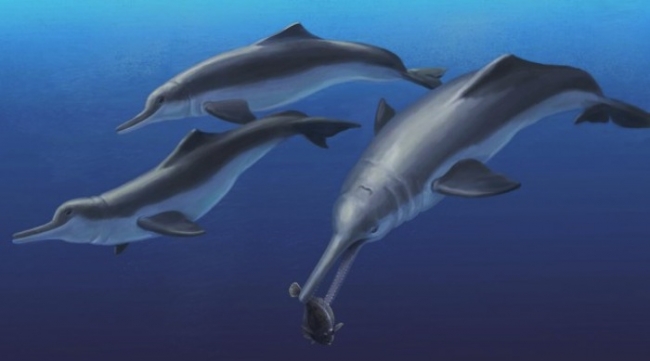An artistic reconstruction of the newly-discovered dolphin “Isthminia panamensis.” (Photo : Julia Molnar, Smithsonian Institution)
Scientists have discovered an ancient genus and species of river dolphin that could provide insight into the animal’s evolutionary history.
Small fossil fragments discovered in Panama revealed the existence of the ancient dolphin, dubbed Isthminia panamensis, the Smithsonian reported. The fossil is believed to date back as far as 6.1 million years and consists of: half a skull; a lower jaw with an almost full set of teeth; and bones from the shoulder and flipper. The findings suggest the ancient dolphin measured in at about nine feet in length.
Today there are only four species of river dolphin, and all of them are considered to be endangered. These species differ from their marine counterparts by “broad, paddle-like flippers, flexible necks and heads with particularly long, narrow snouts,” all to help them better navigate a freshwater environment. These new findings suggest freshwater dolphins were once much more widespread than they are today. Now, researchers are working to determine when in history dolphins moved from oceans to rivers.
“We discovered this new fossil in marine rocks, and many of the features of its skull and jaws point to it having been a marine inhabitant, like modern oceanic dolphins,” said the study’s lead author Nicholas D. Pyenson, curator of fossil marine mammals at the Smithsonian’s National Museum of Natural History. “Many other iconic freshwater species in the Amazon, such as manatees, turtles and stingrays have marine ancestors, but until now, the fossil record of river dolphins in this basin has not revealed much about their marine ancestry. Isthminia now gives us a clear boundary in geologic time for understanding when this lineage invaded Amazonia.”
The existence of other ancient marine fossils at the Panama site suggest a salt water environment existed before the full closure of the Panama Isthmus.
“Isthminia is actually the closest relative of the living Amazon river dolphin,” said study co-author Aaron O’Dea, staff scientist at the Smithsonian Tropical Research Institute in Panama. “While whales and dolphins long ago evolved from terrestrial ancestors to fully marine mammals, river dolphins represent a reverse movement by returning inland to freshwater ecosystems. As such, fossil specimens may tell stories not just of the evolution these aquatic animals, but also of the changing geographies and ecosystems of the past.”
The findings were published in a recent edition of the journal PeerJ.
